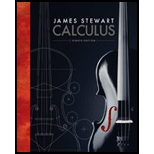
A particle P moves with constant angular speed
(a) Find the velocity vector v and show that
(b) Show that the speed
(c) Find the acceleration vector a. Show that it is proportional to r and that it points toward the origin. An acceleration with this property is called a centripetal acceleration. Show that the magnitude of the acceleration vector is
(d) Suppose that the particle has mass m. Show that the magnitude of the force F that is required to produce this motion, called a centripetal force, is

a)
To find:
The velocity vector
Answer to Problem 1P
Solution:
Explanation of Solution
1) Concept:
If
2) Given:
3) Calculation:
Consider
The velocity vector at time
Therefore, differentiating
Now
As
Since
Conclusion:
b)
To show:
The speed of particle
Answer to Problem 1P
Solution:
Explanation of Solution
1) Concept:
Speed of a particle is the magnitude of velocity vector
2) Given:
3) Calculation:
From part (a),
Therefore, as the speed of a particle is the magnitude of velocity vector
The period
At the speed
Therefore, period is
Conclusion:
The speed of particle
c)
To find:
Acceleration vector
Answer to Problem 1P
Solution:
Explanation of Solution
1) Concept:
The acceleration of a particle is
2) Calculation:
From part (a),
The acceleration of particle is
Therefore, differentiating
This concludes that acceleration is proportional to
The acceleration with this property is called centripetal acceleration.
Now, the magnitude of acceleration vector is given by
Conclusion:
The acceleration of particle is
Magnitude of acceleration vector is given by
d)
To show:
The magnitude of force required to produce this motion is
Answer to Problem 1P
Solution:
Explanation of Solution
1) Concept:
Here use Newton’s Second Law of motion.
Newton’s Second Law:
If at any time
2) Calculation:
By using Newton’s Second Law of motion,
Therefore, magnitude of force required to produce this motion is
From part (c),
Hence,
Conclusion:
The magnitude of force required to produce this motion is
Want to see more full solutions like this?
Chapter 13 Solutions
Calculus (MindTap Course List)
- Algebra & Trigonometry with Analytic GeometryAlgebraISBN:9781133382119Author:SwokowskiPublisher:Cengage
